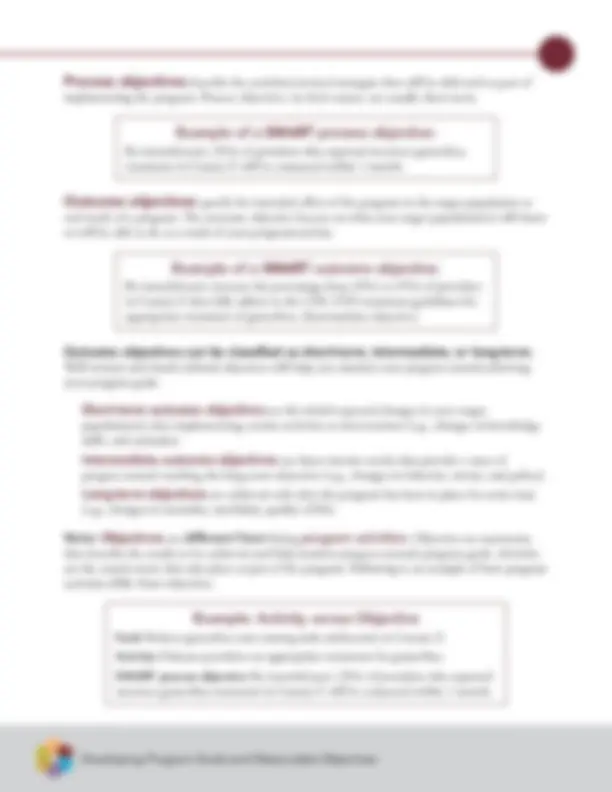



Study with the several resources on Docsity

Earn points by helping other students or get them with a premium plan


Prepare for your exams
Study with the several resources on Docsity

Earn points to download
Earn points by helping other students or get them with a premium plan
Community
Ask the community for help and clear up your study doubts
Discover the best universities in your country according to Docsity users
Free resources
Download our free guides on studying techniques, anxiety management strategies, and thesis advice from Docsity tutors
Guidance on developing program goals and measurable objectives for std prevention programs. It explains the importance of goals and objectives, and provides criteria for creating smart objectives. Examples of process and outcome objectives are given, along with tips for writing goals and objectives.
What you will learn
Typology: Slides
1 / 2

This page cannot be seen from the preview
Don't miss anything!


Program goals and objectives establish criteria and standards against which you can determine program performance. You will need to identify the goals and objectives of the program component or intervention you plan to evaluate. Logic models are a useful tool that can help you do this.
A broad statement about the long-term expectation of what should happen as a result of your program (the desired result). Serves as the foundation for developing your program objectives. Criteria: 1) Specifies the STD problem or STD-related health risk factors;
For more information and examples, see Steps 2.2–2.3 in the Practical Use of Program Evaluation among STD Programs manual. http://www.cdc.gov/std/program/pupestd.htm TIP: Complete Exercise 2: “Writing Goals and Smart Objectives” on pages 64–65 of the manual. National Center for HIV/AIDS, Viral Hepatitis, STD, and TB Prevention Division of STD Prevention CS
implementing the program. Process objectives, by their nature, are usually short-term.
By (month/year), (X%) of providers who reported incorrect gonorrhea treatment in County Z will be contacted within 1 month.
end result of a program. The outcome objective focuses on what your target population(s) will know or will be able to do as a result of your program/activity.
By (month/year), increase the percentage from (X%) to (Y%) of providers in County Z that fully adhere to the CDC-STD treatment guidelines for appropriate treatment of gonorrhea. [Intermediate objective] Outcome objectives can be classified as short-term, intermediate, or long-term. Well-written and clearly defined objectives will help you monitor your progress toward achieving your program goals. Short-term outcome objectives are the initial expected changes in your target population(s) after implementing certain activities or interventions (e.g., changes in knowledge, skills, and attitudes). Intermediate outcome objectives are those interim results that provide a sense of progress toward reaching the long-term objectives (e.g., changes in behavior, norms, and policy). Long-term objectives are achieved only after the program has been in place for some time (e.g., changes in mortality, morbidity, quality of life). Note: Objectives are different from listing program activities. Objectives are statements that describe the results to be achieved and help monitor progress towards program goals. Activities are the actual events that take place as part of the program. Following is an example of how program activities differ from objectives.
Goal: Reduce gonorrhea rates among male adolescents in County Z. Activity: Educate providers on appropriate treatment for gonorrhea. SMART process objective: By (month/year), (X%) of providers who reported incorrect gonorrhea treatment in County Z will be contacted within 1 month. Developing Program Goals and Measurable Objectives